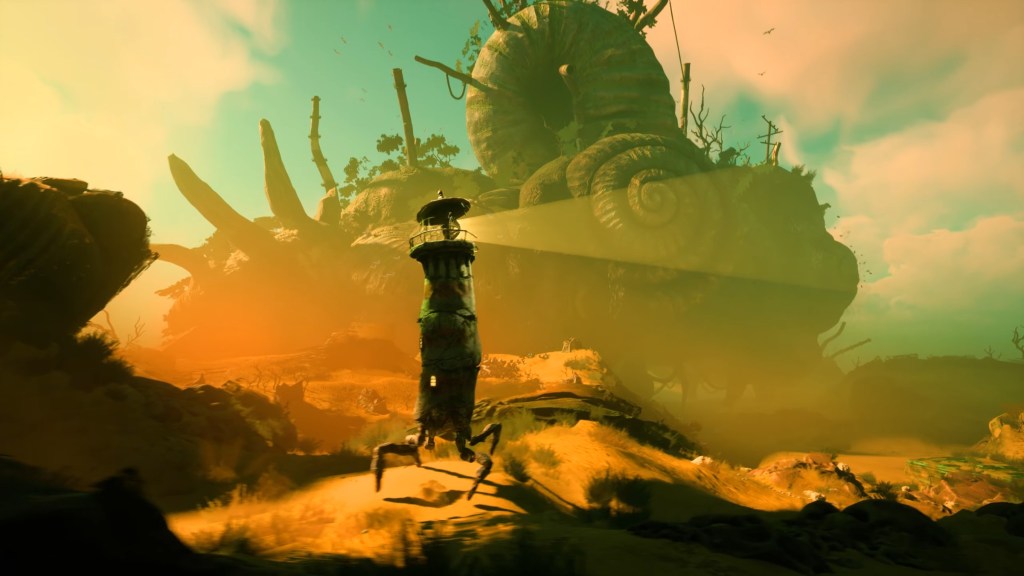On paper, Keeper is one of the stranger propositions for gamers to get behind. Taking control of a lighthouse in a post-humanity landscape, there is little in terms of standard action or platforming to be found. It’s methodical and meditative in a way few other titles could ever strive to be. It’s slow — deliberately so — and infused with a deep aura of ambiguity and natural mystery. It’s hard to explain what makes Keeper so engrossing by just describing it, beyond the stunning graphics.
Videos by ComicBook.com
Having played it, I can attest to it being something far more than it appears. Double Fine’s Keeper is one of the best arguments for gaming as an art form in recent memory, a nature walk with puzzles that make up for their lack of challenge with a sense of bittersweet whimsy and colorful decay. While it might not be for everyone, Keeper is a good reminder about the artistic core of Double Fine as a studio and what gaming can do when it’s willing to experiment with style and form.
Score: 4.5/5
| Pros: | Cons: |
| Gorgeous visuals speak to a level of craft rarely seen in the AAA-gaming space. | A relatively straightforward gameplay loop can grow repeitive. |
| A purposefully slow pace encourages natural exploration in a gorgeous setting. | A focus on calm vibes leaves much of the game without a sense of stakes. |
| Strong worldbuilding and confidently ambiguous storytelling benefit the design aesthetic and storytelling | Not for everyone |
An Xbox Game Unlike Any Other You’ve Ever Seen

Keeper is one of the most artistic works to ever be released on an Xbox, trading in quick-paced gameplay loops for a largely silent exploration of a forgotten world. Taking place on a version of the world where humanity has long since disappeared, and only the remnants of civilization remain, a solitary lighthouse sprouts legs and starts exploring the environment. There’s a helpful bird who accompanies the lighthouse as it explores the world, as well as a foreboding swarm of dark entities that can often be seen circling the sky for some unknown cause.
Delving any further into the admittedly light story would risk spoiling the intent behind the ambiguous narrative, but none of that should detract from the sheer artistry on display. At times, it feels more like a conceptual take on a Pixar movie than a standard Xbox game. Keeper is at its best when it is expanding its world through natural exploration. There’s little in the form of standard combat, with an emphasis instead placed on puzzle solving and environment interaction. This leans into the game’s core strengths, highlighting the visual worldbuilding and encouraging players to explore for the simple act of exploring.
There’s something almost beautifully tragic about the state of the world in Keeper, with the art design illustrating a vast world where the ruins of villages crumble under the player’s feet. However, the off-kilter charm that Double Fine perfected with the Psychonauts games is on full display here, fully taking over the experience instead of trying to find a balance between the gameplay and the worldbuilding.
Become The Lighthouse

Calling Keeper a walking simulator may seem a bit harsh, but that’s very much the spirit of the game. Platforms are relatively easy to overcome, and players’ harshest task early on is adjusting to the off-balance steps the lighthouse makes. There isn’t necessarily an attack function for the lighthouse, with the focus instead being placed on an ability to shine a light that can solve puzzles, force back entities, and help flowers around the map bloom.
Puzzles can also be resolved with a press of a button, which will send the avian companion off to collect an item or peck at a problem. Perilious drops don’t offer much risk. It’s a very straightforward experience from a gameplay standpoint, unassuming in its casual exploration of a world that was never built for the lighthouse. The puzzles are straightforward and not necessarily challenging, but that’s not a complaint. Instead, the simple tasks lead to mini-stories, like awakening a slumbering elemental or creating a bridge from newly sprouted tree trunks. It all feeds into the sense of wonder and exploration key to Keeper‘s experience.
The puzzles take on a harder edge in the game’s third act, which is also when the world expands away from the fairly linear path of the earlier sections. This is the section of the game that will most appeal to standard gaming fans, with an encouragement of exploration that rewards players for having mastered the lighthouse’s spider-like movement. Even then, though, Keeper remains focused on its emotional tone and visual style above all else.
Gamers looking for a thrill a minute will likely be confounded by the game’s deliberately slow pace, or grow quickly tired of the standard puzzle loop. Even cozy puzzle fans should be aware that this isn’t anything like what’s come before it. Even as it takes cues from other titles, there’s a unique and meditative spirit to the lighthouse’s journey that makes for a far slower-paced game than most players are used to. However, those players may not see Keeper for what it really is.
Keeper Is The Artsy Pixar Film Of Mainstream Gaming

The closest comparison that comes to mind for Keeper is the first act of Wall-E. The animated sci-fi film from Pixar opens with a largely silent introduction to the titular robot, who remains charming in the face of a long-abandoned Earth. While Keeper finds plenty more natural beauty than in the deliberately stark and lifeless Wall-E, both are looking for (and succesfully find) a bittersweet sense of loneliness and curious touch of beauty.
Keeper shouldn’t work as well as it does, with a gameplay style that can quickly become repetitive. In another title, this would have likely impacted the overall review score. Keeper isn’t in most games, though. There’s a genuine level of craft on display, from the haunting score to the vibrant graphics to the memorable character design. It’s hard to understate just how mesmerizing the Keeper can become, especially as a solved puzzle unlocks a new corner of the map or a faraway mountain is casually revealed to be some behemoth creature living its own life.
Xbox users looking for a mile-a-minute gameplay will likely be bored by Keeper‘s ambiguous storytelling and lofty worldbuilding. They should still give it a chance, though. There’s a level of artistry infused in every drop of Keeper that makes it impossible to turn away from. While it may not be the game that players revisit the most this year, it may prove to be one of the most memorable entries to the Xbox library in years. A strong argument that gaming can be just as artistically minded as any film, song, or artwork, Keeper is something special in a medium that’s always in need of more inventive approaches.
A review code for Keeper was provided to Comicbook.com for the purposes of this review.








